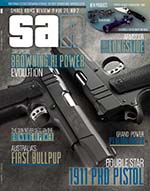Nightforce 2017 Update
By Alton Chiu
Nightforce is a well-known name in the tactical shooting community, with the NXS line being used by the US military. Recently, Nightforce showcased their products at the CORE shooting facility in Baker, FL, where the scopes were partnered with bolt action AX, AXMC and AT rifles from Accuracy International, semi-automatic DD5 and MK12 rifles from Daniel Defense and match-grade ammunition from Black Hills Ammunition, such as the 7.62x51 mm with a 175-gr TMK and 5.56x45 mm with a 77-gr SMK. Although the author is a left-hander, the smooth AI bolt helped him cycle the action quickly with the right hand. The ambidextrous controls of the DD5 also afforded good ergonomics for left-handed shooters, and the author was not affected by the gas or ejected brass. Of note for southpaws is that left-handed models of the AX rifles should ship in the first quarter of 2017.
Amongst the new products for 2017 is the Nightforce ATACR 7-35x56 F1 first-focal plane rifle scope with an MSRP of $3,600-4,000 USD. The author had a chance to use that scope atop an AXMC rifle to hit an IPSC silhouette at just over 1,000 yards. The high quality optics enabled the author to observe thermal mirages for making wind calls, as well as to spot misses. In addition, the author was able to distinguish and engage the same 1,000-yard target during twilight when the sun had sunk below the horizon. Smaller scopes such as the ATACR 4-16x42 F1 paired with the DD5 allowed a more nimble package for positional shooting. When spotting for other shooters, the clarity of the TS80 spotting scope was such that the author could discern the impact locations on a 700-yard steel silhouette.
In speaking with the Nightforce engineers, the author came to understand that the optical performance of the scopes derive from the use of Extra Low Dispersion (ED) glass and achromatic doublets. Dispersion is a phenomenon whereby different wavelengths (e.g., different color of light) travel through a media (e.g., lens) at different speeds and are bent differently.
This results in different focal points for different colors and generates an image that has chromatic aberrations most easily observed as color fringes around a high-contrast object. A single convex lens can only bring one wavelength into focus at one point. An achromatic doublet has two lenses (convex and concave pair) that bring two different wavelengths into focus at a common point. Apochromatic lenses have three elements and are able to focus three different wavelengths. This problem is similar to approximating a curve with the Fourier series: the higher the number of terms (i.e., elements), the better the approximation (i.e., more varying wavelengths are focused at the same point). ED glass is used in the convex lens to further control chromatic aberration. Current Nightforce designs use achromatic lenses with ED glass to balance cost and performance.
In addition to the tactical-oriented products, some Nightforce products are well-suited to the CMP service rifle competition. With the 2016 rules changed to allow scopes up to 4.5x in service rifle competition, military shooting teams such as the AMU asked Nightforce for such a scope in time for Camp Perry less than a year away. Instead of designing a new scope from the ground up with a lead time of about two years, Nightforce answered by modifying an NXS 1-4x28 as the Competition SR Fixed 4.5x24. An extended mount was also introduced to put the scope further forward for proper eye relief with the nose-to-charging-handle shooting style.
New in 2017 is the new carbon fiber tripod that is not only strong enough to shoot from but also features detachable center section and legs for maximum flexibility. It can be set low enough for use with a spotting scope in prone, and it can also be adapted as a monopod as well. MSRP is $395. Lastly, Nightforce is releasing the new Mil-C reticle developed upon request from PRS competitors. It is similar to the Mil-R reticle but has 0.2-mil instead of 0.5-mil marks. It is available in the ATACR 5-25x56 F1 in Spring 2017.
This article first appeared in Small Arms Review V21N2 (March 2017) |
| SUBSCRIBER COMMENT AREA |
Comments have not been generated for this article.






